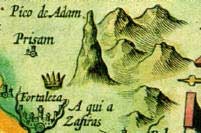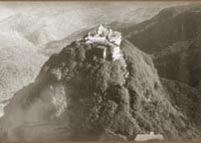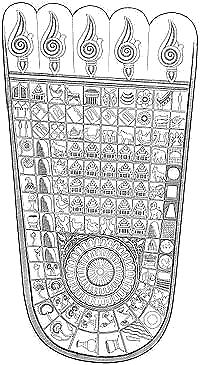The Lure of Sri Pada

|
 |
by Aryadasa Ratnasinghe
The open semester to Sri Pada, the holy mountain, begins on the 'Unduvap' (December) full moon day and ends on the 'Vesak' full moon day (May) in the ensuing year. This mountain is also known as Samantakuta, Sumanakuta, Samanalakanda, Samanhela, Samangira, Medumhelaya, etc. The Christians call the mountain Adam's Peak, derived from the Portuguese Pico de Adam ('Peak of Adam').
This conical mountain is situated 16 km northeast of Ratnapura, and rises much abruptly from the lower valley than any other mountain in the island. Although it is not the highest mountain, it rises to a trignometrical altitude of 2,243 m. (7,360 ft.) above sea level, offering an unobstructed view over land and sea, overlooking the South Central mountain ridges.
The splended view of the tropical wilderness, with its hills, dales and plains, all luxuriantly wooded, bounded by blue mountains, fleecy clouds resting on low ground, and a brilliant sky over-head adds to the panorama of the resplendent island. The charms of the prospects are heightened by the coolness and freshness of the air, and by animation of the scene produced by the singing of birds, in addition to the harsh cries of the wild peacock and the jungle fowl.
From remote antiquity, the visibility of the conical mountain from vessels off-shore to a distance of about 15 km, excited great interest of foreigners, when the island's interior was unknown to the outside world. It was also the landmark of the sea-faring Arabs, Moors, Greeks and Persians, who came to the island to barter in gems, ivory, spices, elephants etc.

Footmark
The sacred foot mark atop the mountain (as most of us have seen) is a superficial hollow of gigantic size, measuring 156 cm. in length, and 76 cm. towards the toes and 71 cm. towards the heel in width. There is the belief that the actual footmark lies on a blue sapphire beneath the huge boulder upon the summit, and what we see is only an enlarged symbolic presentation. The placement of such a huge boulder is attributed to god Visvakarma, who had done so for purpose of protection.
The summit is a small plateau, having an area of 164 sq.m., or 1,776 sq.ft. (74 X 24 ft.), according to measurement taken by Lieut. Malcolm of the British Rifle Regiment, the first European to ascend the mountain in 1816. He had signalled his arrival at the summit by firing three cannon shots from his swivel musket, into the valley below.
The sacred footmark as seen by Dr. John Davy in 1817, was ornamented with a single margin of brass and studded with a few gems. These are now not to be seen. He says, "The cavity of the footmark certainly bears a coarse resemblance to the figure of a human foot but much oversized. Whether it is really an impression is not very flattering, if not for its huge size. There are little raised partitions to represent the interstices between the toes, to make it appear a human foot."
Robert Knox, the European captive, who spent 20 years (1660-1679), in the Kandyan kingdom, says
According to the Mahavamsa, the Great Chronicle of the Island, the first person to ascend the holy mountain Sri Pada, was King Vijayabahu I (1058-1114), having come to know that atop the mountain is seen the footmark of the Buddha. It is said that he had gathered this information from the pious woman Manimekhala, who, as a devout Buddhist, was living in South India. Another version is that the King had seen, in the early hours of one morning, angels plucking flowers in his garden. When questioned, one of them had said "We are plucking flowers to worship the footmark of the Buddha atop the Samanalakanda."
Rock Edict
The Ambagamuwa rock edict and the Panakaduwa copper plate bear witness to the royal patronage extended by king Vijayabahu, by building 'ambalamas' (rest camps) on route for the convenience of the pilgrims, and also provided them with food and water. The king also built a lower 'maluwa' (place of worship) for his Hindu consort Tiloka Sundari to make her benefactions to the Hindu deity Siva alias Iswera. Actual pilgrimage to the mountain began during the reign of Śrī Nissankamalla (1187-1196), after he ascended the mountain with his fourfold army with great faith and devotion.
There are two historic approaches to the summit of Sri Pada. The oldest is the Ratnapura path, popularly known as the 'difficult path' via Malwala, Kuruwita, Eratna and Gilimale. The last station is Palabaddala. The path runs through ascending and descending hills, deep valleys, along edge of precipices, with a river foaming beneath and, sometimes, under over-hanging rocks and along the beaten track, highly infested with leeches (blood-sucking worms). On this path, pilgrims have to walk long distances until a camp is reached.
Half way up the mountain, there is a small torrent that flows over an immense tabular mass of rock, which forms the 'Seetagangula' (stream of icy water), the parent stream of the Kalu-ganga. At this point, the scene is very impressive and the atmosphere calm. The pilgrims stop here for a break to perform their ablutions, while some bathe, some make a frugal repast of rice or bread, some rest themselves before making the steep climb, some chew betel and others chat to break the monotony of the jungle.
The itinerant Arab pilgrim Ibn Batuta alias Abu Abdallah Mohammed (1304-1377), and the Venetian traveller Marco Polo (1254-1324), had ventured to reach the summit via the Ratnapura path "to worship the sepulchre of Adam" as they believed the footmark atop the mountain to be that of Adam (the first parent of the human race). From Barberyn (Beruwala), they had followed the Kalu Ganga to the summit.
Path
The other path is the Rajamawatha (now the Hatton path), and it came to be so known because many kings, during and after the Gampola period (1347-1412), had made their way to the mountain through that path. It began from Gangasiripura (now Gampola) via Ambagamuwa, Kehelgamuwa, Ulapangama, Horakada, Dagampitiya, Makulumulla, Hangarapitiya, and by the Laxapana pass to the summit. There is also a 'Seetagangula' on this route which is the parent stream of the Mahaveli-ganga.
The Rajamawatha was constructed by the Chief Minister Devapathiraja who served under King Parakramabahu III (1283-1293). Pilgrims travelling by train break journey at Hatton (173 km. from Colombo) on the Main Line, and continue by bus to Maskeliya and thence to the Delhousie Bazaar, from where all transport facilities cease. A serpentine gravel road leads the way to the Sama Cetiya, en route, where camping is available for cooking food and for resting. The next halt is the 'Seetagangula', where pilgrims get ready to make the ascent.
A group of pilgrims is known as a 'nade' and the chief is the 'nade gura' who is supposed to have made many visits to the holy mountain during his lifetime. A newcomer is known as 'kodukaraya' and he or she is at the mercy of the 'nade gura'. Age is no barrier to this novice.
As we see from the valley below, the upper part of the mountain is free from jungle growth. Only tundra vegetation adorns the granite surface, as such incomplete plant layers are generally characteristic to exposed sites under humid tropical conditions. Climbing this part of the mountain is risky, if not for the concrete steps now built because the surface of the bare rock is slippery at most places, where water flows from in between crevices of the rock.
Before the concrete steps were built from Indikatupana to the summit, iron railings fixed on to iron posts driven into the rocky surface, supported the pilgrims along this stretch, to make the ascent safely. It is said that these railings were fixed on the orders of Alexander the Great (BC 356-323), the Macedonian king, for pilgrims to ascend the mountain without risk to their lives.
Many pilgrims make an effort to reach the summit before dawn to witness the unique phenomenon known as the 'irasevaya' (the effulgence of the rising sun) extremely bright and splendid, as it punctures the eastern horizon like a ball of fire. Simultaneously, on the western side of the mountain slope could be seen the conical shadow of the mountain as it falls upon the valley below. Buddhists call this natural phenomena as the worship by sun-god.
The apostate Rajasinha I (1581-1592), the king of Sitawaka, in order to overcome the retribution of patricidal sin in killing his father Mayadunna of Sitawaka, assigned the administration of the holy mountain to a non-brahminical Saiva sect known as 'Andis' of South India. He did so on the advice of his Hindu priest Arittakivendu Perumal. These 'Andis' collected enormous wealth offered to the footprint by the devout Buddhists. King Kirti Śrī Rajasinha (1747-1781) appointed Ven. Asarana Sarana Saranankara Sangharaja thera, as the new incumbent of the holy mountain to preserve it from further damage.
Saman Deviyo
With the onset of the open semester, the statue of god Saman (the tutelary deity of the mountain), along with the insignia of his divine vehicle (white elephant) and other sacred paraphernalia are carried to the mountain in procession, to be placed within the niche below the summit. During the close semester (June to November), these objects of veneration are safely deposited at the Galpottawala Rajamaha vihara at Pelmadulla. At the appointed time, they are taken out, in the presence of the incumbent priest of the temple, and make the historic journey (now through the Hatton path), after a short break at the Maha Saman Devale in Ratnapura.
The collosal brass lamp ('dolosmahe pahana') atop the mountain, which keeps burning through night and day, is an offering made by King Virawickrema in 1542. Fuel is supplied by the pilgrims in the form of oil, copra etc., to keep the lamp burning.
Courtesy: The Daily News of 7 January 2002.